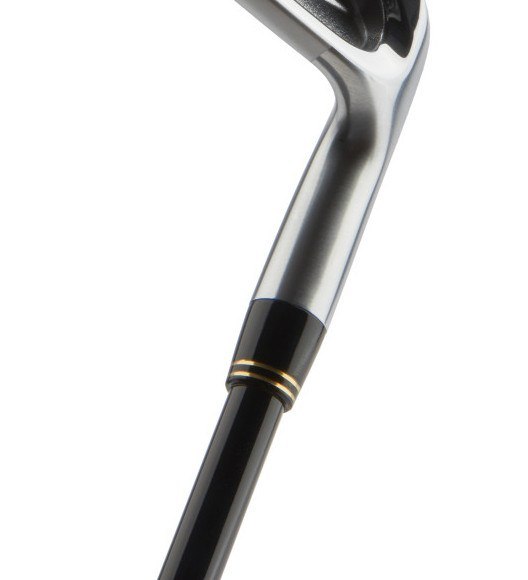Unless you took up golf in the last two decades, the idea of choosing one shaft over another was not really something that anyone every asked. As a junior, I have literally no idea what was in my clubs. I had certainly never seen graphite, even in a driver, and I was probably swinging the same heavy True Temper R300 shafts as most people. In the early 2000s, graphite shafts began to appear in drivers and today, outside of anyone (like me) who has an old school bag or back up bag, all woods are going to be graphite shafted. Steel vs graphite shaft only actually becomes a choice once you get to long irons or hybrids and above.
Steel vs Graphite: Advantages and Disadvantages
In fact, it is pretty much a given that the longer the club, the more likely you are to find a lighter shaft in there, and that generally means graphite. Some of the fastest swinging professional golfers on the planet have lighter (not light, but lighter carbon shafts in their long irons. If someone who swings their driver at 130 miles an hour has a lightweight graphite shaft in their 3 iron, it might well make sense for the rest of us mortals who swing at a more sedate pace too.
When we get to the mid and short irons, the debate becomes a lot more interesting. These irons are, or at least should be, clubs that we use to hit a particular distance, not to hit as far as possible. This is the first argument that is generally put forward by the proponents of steel shafts. A steel shaft offers far more control and given that irons are control clubs, steel makes sense. But how true is this really?
The problem lies a little bit in the fact that the early graphite shafts used in irons really weren’t that stable at all. They were designed for basically senior golfers with very slow swing speeds or average to slow-speed women. The fact that these shafts weren’t the most robust didn’t matter for this market. Someone who is swinging their 7 iron at 65 miles an hour isn’t causing the shaft to twist too much at all. The graphite is doing exactly what it is supposed to in this case: protect those aging joints by reducing vibration and being lighter and easier to swing, especially later on in the round.
The Problems with Graphite Golf Shafts
It wasn’t that these were exactly low tech shafts. In my opinion, nobody in the golf industry thought that they would be a serious option for even the average speed amateur bogey player. As time went on, the research and development that was going into driver shafts filtered down into iron shafts. It became standard for the fastest swinging professional golfers on the planet to have graphite shafts in their drivers and today, this is absolutely normal. They aren’t worried about “overpowering the shaft” simply because it is graphite.
If you have ever played with a driver shaft that is too stiff, you will know that graphite stands up very well to some pretty aggressive swings. As an example, I have project x 6.5 steel shafts in my irons currently. They are almost certainly a little bit too stout for my swing nowadays, but far from being unplayable. I have tried a 6.5 (graphite) in my driver which is, relatively speaking, not as fast as my irons in terms of swing speed, and I struggle. I feel like I really have to try to smash it in order to get the shaft to work for me. I certainly don’t feel like I am in danger of overpowering at all.
This is the problem when considering graphite vs steel shafts and perhaps the reason why more golfers don’t give them a serious go in their irons. Those who have tried generally haven’t tried something that works in the same way as they are used to in their steel shafts. Changing weight from 130g to 70g is going to make a huge difference in how the club feels, how it performs and the confidence we have standing behind the ball.
This image of graphite as being something that you are obliged to use when you get older doesn’t hold true with today’s modern offerings. Seeing Bryson Dechambeau and his 130 miles an hour plus driver speed trying out graphite shafts and describing them as ‘like rebar’ should be about all you need to know to put that one to rest.
Steel Shafts aren’t Dead Yet
On the other hand, this doesn’t mean that we should all be putting graphite in all our clubs either. Many golfers, myself included most of the time, are perfectly happy with the results and the feel of steel shafts. We should probably all look at least going a little lighter than is traditionally the case, but graphite isn’t the only choice either.
Staying with steel isn’t just about feel or performance either. Cost is a real issue today and when we see iron sets selling for over $1500, I can certainly understand why many golfers are reluctant to put in an upgrade of $50 dollars or more for a very exotic graphite option. As I said, sometimes weight is the issue and simply trying to cut a few grams and find a lightweight steel option can make a huge difference. Even the classic True Tempers of my youth are now far more varied and I can get the same feel I am used to in something that comes in under 100g.
In fact, the opposite is also true. It is quite possible to find heavyweight graphite shafts today too. This might seem like a strange choice but surely the reason for going to graphite in the first place is to save weight. This isn’t entirely true though. As I mentioned here, I am toying with graphite or steel fiber shafts currently. I don’t feel like I need to save weight from the 130g shafts I currently have. However, I do have a few tendon and other issues in my elbow and shoulder. If I want to carry on playing with a minimum of pain, something that reduces the vibrations traveling up my arm is probably going to be a necessity soon. Fortunately, I can find something that won’t be that different to my current shafts in the ever-increasing graphite range.
Steel vs Graphite Shaft: Which to Choose?
So where does that leave us in terms of a steel vs graphite shaft? Well it really isn’t an either/or question. The key is to try both and to do so without the preconceived ideas that graphite is for women and pensioners or steel is only for professionals. Taking the time to go to a fitting day at your local club and hit some of the offerings out there, if possible with the rep and some sort of launch monitor, might just surprise you and perhaps lead you down the road to a shaft choice that you didn’t expect.
Of course, you need to get rid of some of the preconceived ideas about shafts that you might still be hanging on to. No, graphite shafts aren’t just for seniors. Yes, some pros do play them. and in the other direction, yes seniors can play heavier steel shafts too. In fact, outside of the true old-school bag which has heavy steel in everything from driver to putter, you won’t find a bag that has just steel shafts anywhere anymore. What might surprise a few people is that the full graphite bag (yes, that does include the putter) does actually exist and might be the most common option in golfer in the next decade or two.
I am not pushing anyone to play one or the other. I have had a lot of success playing steel in hybrids for example, something that is less and less common. however, I am also open to change. I would guess that if I took the time to try out the different options, I might find that one of the many modern graphite options might be good even for this this old man.





